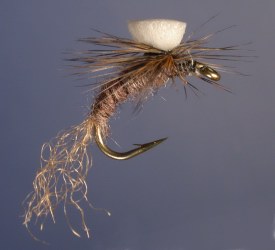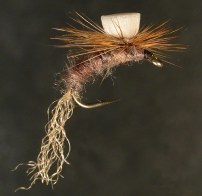Invicta Flies - Pop-Up Emerger
Peter Frailey of Massachusetts shares this pattern with us. No excuses now to avoid fishing emergers... the original strikes me as the perfect companion to the Adams dry fly, matching a good number of naturals. Different sizes and colors can be applied for others. The results- one good pattern to take care of all your mayfly emergers! See Peter's own write-up on the "emerging" of this versatile, yet simple fly pattern.
 |
*Be sure to visit Peter's fascinating site, "Fishing With Flies," for more great patterns and stories about flies from the tiers themselves.
*Also, check out Peter's Woodchuck Special, a streamer which has become one of my favorites.
|
Hook: Tiemco 2487 light scud hook, sizes 14 to 18
Thread: Black Danville 6/0
Tail: A few strands of amber Z-Lon
Post: White foam cylinder
Body: Gray dry-fly dubbing
Hackle: Cree or Grizzly dry-fly hackle, one size smaller than hook size.
Peter writes:
"The Pop-Up Emerger is my variation of the Sangre de Cristo Emerger pictured and described in Dave Hughes' excellent book, “Trout Flies”. Always tinkering with pattern variations, I replaced the standard dry fly hook with a lightweight scud hook, borrowing the idea from the popular Klinkhamer Special. While Dave's pattern (from the Sangre de Cristo Flyfishers in Sante Fe, New Mexico) specifies a strip of yellow closed cell sheet-foam for the post, I chose a white foam cylinder sold under the Rainy's label. In addition to the fact that I can't pronounce Sangre de Cristo, I named my variation the Pop-Up Emerger because the little white dot of foam on the completed fly reminded me of the little white Pop-Up thermometers found on those famous-brand roasting chickens.
During the winter of 2002, the Pop-Up Emerger was my most effective fly on the Swift River, a tailwater fishery in western Massachusetts. The Swift is crystal clear and flows rapidly over a generally smooth bottom covered with sand and green vegetation. I first fished this fly on a windless midday in January, in blazing sunshine. The water temperature was near 40 degrees and the air temperature was in the 50's. Though my dry-fly fishing skills are modest, I caught nearly two dozen native brookies during three hours of fishing and walking, before my feet got cold. I concluded that this was a “pretty good fly”, as neither of the two fishermen I met that day had found much success.
I have not yet fished this fly on other rivers. I suspect that this is because once spring arrives I find myself on rougher rivers where I enjoy primarily nymph fishing. And my limited summer trout fishing is on small mountain streams in northern New England where the standard fare includes foam ants and beetles, Adams parachutes, Griffith Gnats, and small Elk Hair Caddis. September is my time to experiment with hopper patterns and in October I am back to nymph fishing. Nor have I fished this pattern on stillwaters, as my only stillwater fishing is with larger flies targeting bass and panfish.
As a final note, only recently have I been able to tie a reasonably decent parachute. If you don't yet have a parachute tying technique with which you feel comfortable, or if you just like to read about various tying techniques, check out Rob's parachute article and photos, right here on his Web site. His demonstration photos show a calf body-hair post, but his step-by-step instructions will work equally well with a foam post." -Peter Frailey, Massachusetts, USA.
 Tied by Peter Frailey.
|
NOTES: To get the shaggy appearance of an emerging nymph shedding its skin, dub the body somewhat loosely. Letting the black tying thread show through a little helps to enhance the illusion of segmentation.
Peter also recommends the post be trimmed short, as shown, for emergers.
Depending on water conditions, it may also be helpful to paint the top of the foam post a fluorescent color.
|